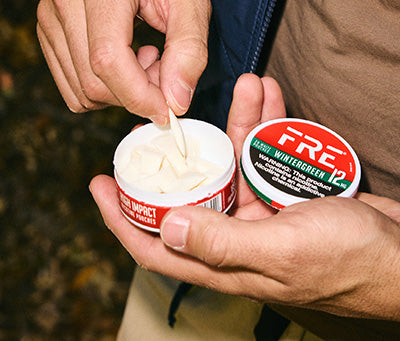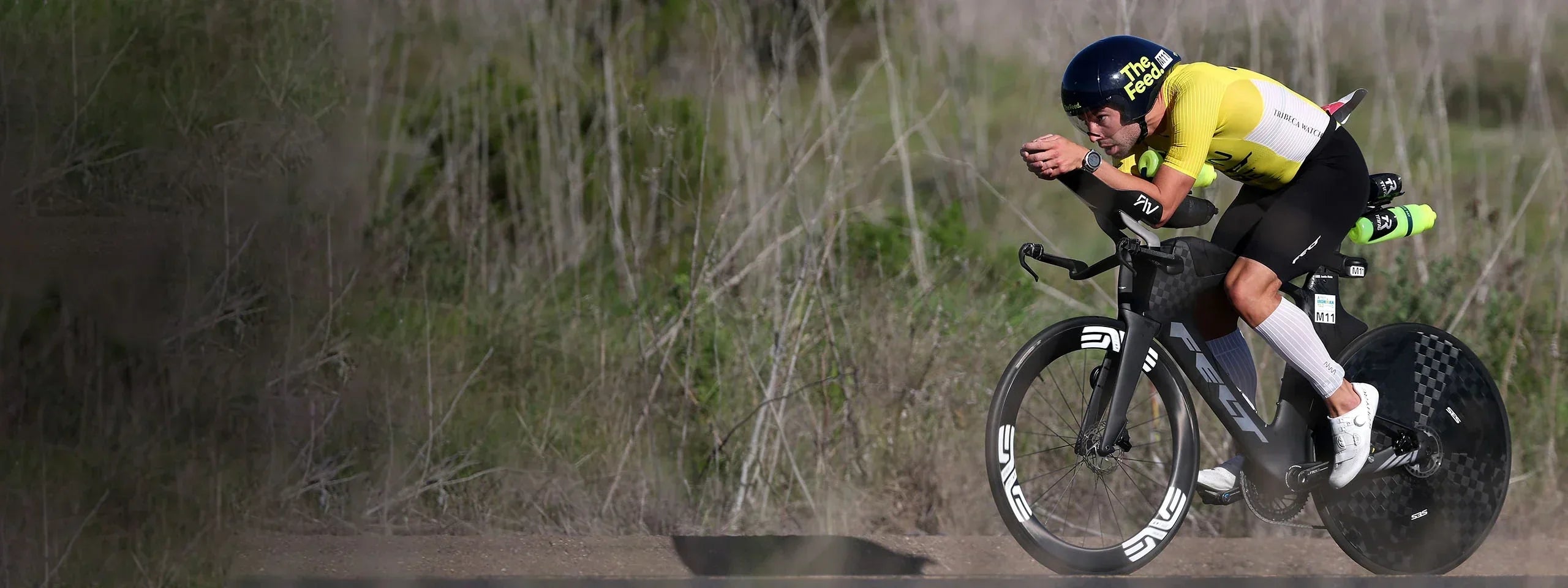You’ve probably heard the term “Ironman” thrown around by athletes or on fitness podcasts, but what is an Ironman, really? At its core, it’s one of the most grueling single-day endurance events on the planet.
An Ironman triathlon combines swimming, cycling, and running across extreme distances. It pushes both physical and mental limits. If you’ve been looking for the next big challenge or just want to know what kind of person signs up for this type of thing, you’re in the right place.
We’re going to get into the key distances, how it started, and what to expect if you're considering a go at it.
Key Takeaways
-
Total distance: 140.6 miles (226.3 km)
-
Composed of: 2.4-mile swim, 112-mile bike, and 26.2-mile run
-
Time limit: 17 hours to finish
-
Founded in: 1978, Hawaii
-
Known as: One of the toughest one-day races globally
That’s right. 140.6 miles, all in a single day. The dedication it takes is no joke. That’s also why so many Ironman athletes focus on the small things, from meal prep to gear and even what they keep in their pockets. Some of them trust little routines that keep their head in the game, FRE pouches included.
What Does an Ironman Race Consist Of?
An Ironman triathlon isn’t just a single sport. It’s a combination of three massive ones, back-to-back:
-
Swimming - 2.4 miles (3.8 km)
-
Cycling - 112 miles (180 km)
-
Running (Ironman Marathon) - 26.2 miles (42.2 km)
You’ll start in the water, usually with a mass swim start (though some races stagger it now), then transition to the bike leg, and finally wrap it all up with a full marathon. And yes, those transitions are timed too.
You don’t get breaks in between. It’s continuous. Each part of the race has its own strategy. Some athletes are stronger swimmers, others save energy for the bike or marathon portion. No matter what, pacing is key. Push too hard early and you’ll struggle.
It’s also worth noting that every athlete has their quirks, gear they won’t race without, snacks that keep them steady, and yes, even preferences for dip pouches that keep their focus sharp without skipping a beat. FRE's Wintergreen and Sweet options are regulars in some gear bags.
Ironman History - How It Came To Be
The idea of the Ironman triathlon came from a debate between swimmers, bikers, and runners about who was the fittest. In 1977, U.S. Navy Commander John Collins and his wife Judy suggested combining all three events into one race. That included:
-
The 2.4-mile Waikiki Roughwater Swim
-
The 112-mile Around-Oahu Bike Race
-
The 26.2-mile Honolulu Marathon
On February 18, 1978, 15 men started the first Ironman in Oahu. Only 12 finished. Since then, Ironman has evolved into a global phenomenon, with over 170 events worldwide.
How Long is an Ironman Race?
You might’ve caught it earlier, but here’s a clearer breakdown of the Ironman distances:
|
Segment |
Distance |
|
Swim |
2.4 miles (3.8 km) |
|
Bike |
112 miles (180 km) |
|
Run (Marathon) |
26.2 miles (42.2 km) |
|
Total |
140.6 miles (226.3 km) |
For those easing into endurance events, there’s also something called a Half Ironman, aka “70.3” races. That means each leg is half the distance:
-
1.2-mile swim
-
56-mile bike
-
13.1-mile run
Still a beast of a race but a more manageable goal for beginners or those balancing training with life.
How Long Do You Have to Finish an Ironman?
Athletes are given 17 hours total to finish the race. The race usually starts at 7:00 AM, and you’ve got until midnight to cross the finish line. But there are cutoff times for each section:
-
Swim Cutoff: 2 hours 20 minutes
-
Bike Cutoff: 10 hours 30 minutes total time
-
Run Cutoff: Finish by the 17-hour mark
How Do Ironman Cutoff Times Work?
Every Ironman triathlon includes strict cutoff times for each leg. You’ve got to hit those benchmarks or you’re out. No medal, no finisher T-shirt, no “you are an Ironman” moment.
If you don’t complete a leg in time, officials will stop you from continuing. It’s tough, but it keeps things safe and fair.
For many athletes, especially beginners, pacing and nutrition make or break their race. That’s why routines and consistency matter, even down to small things like keeping something familiar on hand like a Mint FRE pouch.
What is the Average Ironman Time?
The average Ironman finish time for all participants typically lands around 12 to 14 hours. But this depends on several factors like age, experience, and course terrain.
Average by Division:
-
Male Pros: 8 hours 20 minutes
-
Female Pros: 9 hours 20 minutes
-
Male Age-Groupers: 12 hours 30 minutes
-
Female Age-Groupers: 13 hours 30 minutes
These numbers shift from race to race, but if you’re somewhere in the 12-14 hour range, you’re pacing with the pack.
Ironman Record Times
Want to see how fast the elite athletes go? These times are insane and not something the average person will ever hit. But they show what the human body can pull off with the right training (and a lot of grit).
|
Record Type |
Athlete |
Time |
Event/Year |
|
Fastest Ironman Time (official) |
Kristian Blummenfelt |
7:21:12 |
Ironman Cozumel, 2021 |
|
Fastest Ironman Time (women) |
Laura Philipp |
8:18:20 |
Ironman Hamburg, 2022 |
|
Fastest Iron-Distance (non-Ironman) |
Magnus Ditlev |
7:23:24 |
Challenge Roth, 2024 |
|
Fastest Iron-Distance (women) |
Anne Haug |
8:02:38 |
Challenge Roth, 2024 |
|
Fastest Kona (Ironman World Champs) |
Patrick Lange |
7:35:53 |
Kona, 2024 |
|
Fastest Kona (women) |
Lucy Charles-Barclay |
8:24:31 |
Kona, 2023 |
|
Fastest 70.3 (Half Ironman, men) |
Martin Van Riel |
3:26:06 |
70.3 Dubai, 2022 |
|
Fastest 70.3 (Half Ironman, women) |
Taylor Knibb |
3:53:02 |
70.3 World Champs, 2023 |
These records are constantly being challenged as gear, training, and strategy evolve. If you’re training for fun or aiming to qualify for a serious race, tracking record times can give you motivation. But don’t stress about matching them. Just finishing a race makes you part of a pretty elite crew.
Former Ironman Champions
Some athletes helped define what an Ironman is. From early trailblazers to modern legends, these champions shaped the sport through raw effort, fierce comebacks, and history-making moments.
-
Dave Scott: Known as “The Man,” he won the Ironman World Championship 6 times in the 1980s and later came back in his 40s to finish second and fifth.
-
Mark Allen: Claimed 6 Kona victories, including the iconic 1989 “Iron War” against Dave Scott. Inducted in 1997.
-
Paula Newby-Fraser: The “Queen of Kona,” she won 8 world titles and inspired the global growth of the sport during the '90s.
-
Chrissie Wellington: Four-time champion (2007–2011), known for her undefeated Ironman career and record-setting dominance.
-
Lucy Charles-Barclay: Finally claimed her first Ironman World Championship title in 2023 after four consecutive runner-up finishes.
-
Patrick Lange: Current course record holder at Kona (7:35:53 in 2024), pushing the limits for modern endurance racing.
-
Natascha Badmann: Six-time world champion and the first European woman to win Kona.
-
Fernanda Keller: Six-time third-place finisher at Kona and Brazil's most iconic triathlete, competing in the championship 27 times.
-
Kathleen McCartney: 1982 champion who famously passed a crawling Julie Moss at the finish line, creating one of Ironman's most iconic moments.
What is the Ironman Pro Series?
The Ironman Pro Series is where the sport gets real competitive. It’s a series of races across the globe where professional triathletes go head-to-head for prize money and rankings. Points from these events contribute to an overall season ranking, helping determine qualification for the Ironman World Championship and other elite races.
Big names like Justin Riele, a rising star in the Ironman Pro circuit, use these races to make their mark. We actually got the chance to feature him in an interview on our site. He talks about balancing the intensity of Ironman prep with keeping a solid routine, something a lot of us can relate to, even if we’re not racing Kona.
The Pro Series adds an extra layer of hype to the sport, with more people following race outcomes, athlete stories, and the gear they use. It’s a great entry point for fans new to triathlon.
How to Sign Up For an Ironman Triathlon?
If you're thinking about signing up, you’ll need to pick your race and register early. These events sell out months in advance.
Steps to Sign Up:
-
Visit ironman.com
-
Select a race that fits your schedule and fitness level
-
Create an Ironman account and register
-
Pay the entry fee (often $700+)
-
Receive your race confirmation and info packet
Some events also require a qualifying time, but many age-group races are open entry. Just keep in mind, entry is just the beginning; you’ll be training hard to get ready.
How to Train for an Ironman
If you're planning to take on an Ironman, you can’t wing it. Training is where the real challenge lives. You’ll spend months building endurance, mastering transitions, and dialing in your gear.
Selecting a Suitable Ironman Challenge
Not every Ironman race is the same. Some have rough open water swims, others feature long hills on the bike leg. Here are three popular Ironman races to consider:
-
Challenge Roth (Germany): Known for its fast course and massive crowds
-
Ironman Hamburg (Germany): Flat bike course, great for first-timers
-
Ironman Tallinn (Estonia): Cooler weather and a scenic route
Set Your Goals
You don’t have to aim for a podium. Maybe you want to beat your last time. Or just finish with enough strength left to smile. The point is: have a goal. Without one, it’s hard to stay motivated during the long months of prep.
Swim
Most people find the swim the most intimidating. It’s 2.4 miles in open water—no lane lines, no pushing off walls. You’ll want to train in lakes or oceans to mimic race conditions. Practice sighting and swimming with a crowd.
Cycle
The 112-mile bike ride makes up the bulk of your time. It’s also where you can make up ground or lose steam. Long rides are essential, and so is learning how to fuel while moving. Ride outdoors when you can, especially on hilly routes.
Run
After hours on the bike, your legs feel like jelly. That’s why brick workouts (bike immediately followed by a run) are a core part of Ironman training. You’ll need to train your body to transition efficiently and handle the marathon even when you're exhausted.
Training this hard means your gear game has to be on point right down to what’s in your back pocket. Long rides or treadmill days? FRE’s Refill Can makes it easy to keep your supply stocked without fumbling for fresh cans during your ride prep. Easy to stash, easy to refill.
Nutrients You Should Be Consuming Before a Race
What you eat (and drink) matters—big time. Long races mean long fuel needs. Here’s what you should have in your system in the days and hours leading up to the race.
|
Nutrient |
Why It Matters |
|
Carbohydrates |
Main energy source, think pasta, rice, oats |
|
Protein |
Helps with muscle repair and strength |
|
Fat |
Supports endurance for long races |
|
Sodium |
Keeps your electrolyte levels balanced and helps prevent cramps |
|
Potassium & Magnesium |
Important for hydration and muscle function |
What works for one athlete may not work for another, so training with your nutrition plan is just as important as training your legs. You’ll want to simulate race-day fueling on long training days so your stomach knows what’s coming.
We’ve had a few long-distance cyclists tell us they throw in a FRE Original nicotine pouches in their gym bag. It’s just part of their prep, same as their hydration tablets and compression socks. You find what works and keep it close.
Popular Ironman Events Around the World
Some Ironman races are iconic. They attract athletes from every corner of the world, and landing a spot is often a bucket list achievement.
-
Kona, Hawaii, USA: The Ironman World Championship is held in Kailua-Kona. Known for intense heat, wind, and brutal hills. It’s invite-only, so you’ve got to qualify.
-
Cairns, Queensland, Australia: A scenic course through the rainforest and Great Barrier Reef region. It’s beginner-friendly and extremely well-organized.
-
Barcelona, Spain: Fast and flat. Athletes love it for PR potential and the incredible seaside views.
-
Nice, France: Challenging hills and a beautiful Mediterranean backdrop. The swim starts from a pebble beach. Unique and tricky.
-
Copenhagen, Denmark: This one’s flat and fast, perfect for newcomers. Plus, the locals come out in droves to cheer on athletes.
Final Words
So, what is an Ironman? It’s 140.6 miles of swimming, cycling, and running and is one of the toughest physical challenges out there. It’s a test of consistency, grit, and planning.
If you're gearing up for your first Ironman or your tenth, keep your gear light and your routines tight. FRE helps you prep smarter with pouches that travel easy, stay sealed, and are available in bundles as well.
Stay locked in from training to race day, check out the full lineup and subscribe to our newsletter for updates about special deals and new releases.





